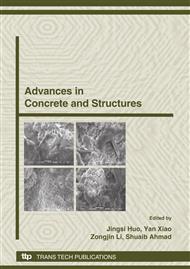[1]
C.H. Kang, K.J. Shin, Y.S. Oh, T.S. Moon: Engineering Structures Vol. 23 (2001), pp.1194-1201.
Google Scholar
[2]
H.T. Hu, C.S. Huang, M.H. Wu and Y.M. Wu: Journal of Structural Engineering, ASCE Vol. 129 (2003), pp.1322-1329.
Google Scholar
[3]
Hibbitt, Karlson and Sorensen Inc. ABAQUS/standard user's manual, version 6. 4. 1. Pawtucket, RI: Hibbitt, Karlsson and Sorensen Inc., (2003).
Google Scholar
[4]
Y.M. Alostaz, S.P. Schneider: Journal of Constructional Steel Research Vol. 40(1996), pp.95-127.
Google Scholar
[5]
S.P. Schneider: Journal of Structural Engineering, ASCE Vol. 124(1998), pp.1125-38.
Google Scholar
[6]
W. Liu, L.H. Han: Chin J Civil Eng Vol. 39(2006), pp.19-27 (in Chinese).
Google Scholar
[7]
L.H., Han, J.S. Huo: Journal of Structural Engineering, ASCE Vol. 129(2003), pp.68-78.
Google Scholar
[8]
L.H. Han, J.S. Huo and Y.C. Wang: Journal of Constructional Steel Research Vol. 61 (2005), pp.882-901.
Google Scholar
[9]
L.H. Han and X.K. Lin: Journal of Structural Engineering, ASCE Vol. 130 (2004), pp.1807-1819.
Google Scholar
[10]
L.H. Han, J.S. Huo and Y.C. Wang: Journal of Structural Engineering, ASCE Vol. 133 (2007), pp.800-814.
Google Scholar
[11]
J. Lubliner, J. Oliver, S. Oller, et al.: Int. J. Solids Struct Vol. 25(1989), pp.299-326.
Google Scholar
[12]
J. Lee, G.L. Fenves: Journal of Engineering Mechanics Vol. 124 (1998), pp.892-900.
Google Scholar
[13]
V. Birtel, P. Mark: ABAQUS Users' Conference, 2006, pp.95-108.
Google Scholar
[14]
L.H. Han, G.H. Yao and Z. Tao: Thin-Walled Structures Vol. 45(2007), pp.24-36.
Google Scholar
[15]
H. Qu, in: Behaviors and calculations on the beam-column connections of concrete-filled steel tubular column structures, Doctoral engineering thesis, Fuzhou University, 2007. (in Chinese).
Google Scholar
[16]
B. Wu, Z.C. Ma and J.P. Ou: Earthquake engineering and engineering vibration Vol. 17(1997), pp.36-43.
Google Scholar
[17]
C. Xu, in: Research on the aseismic and fire resistance behaviors of square concrete-filled thin-walled steel tubular columns with longitudinal stiffeners, Doctoral engineering thesis, Harbin Institute of Technology, 2007. (in Chinese).
Google Scholar
[18]
L.H. Han, L. Xu and X.L. Zhao: Advances in Structural Engineering-An International Journal Vol. 6 (2003), pp.121-133.
Google Scholar
[19]
B. Wu, in: Research on the interfacial bond properties of concrete-filled steel tube reinforced concrete before and after exposure to fire, Master engineering thesis, Zhejiang University, Hangzhou, 2006. (in Chinese).
Google Scholar


